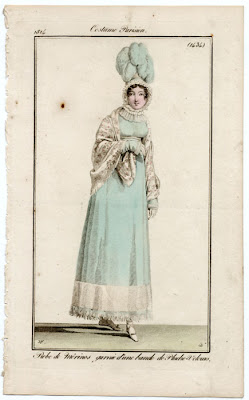My first War of 1812 event,
Attack on Fort Cassin, is now a week away. In preparation for this event, as
mentioned in an earlier post, I've been doing some research and working on a new set of clothes. I haven't completed as much as I would have liked due to lack of time, and well, an almost complete shift of gears to the 20th century. Most of my posts lately have focused on 1930s and 1940s related topics and I do apologies to those of you who follow this blog mainly for those earlier topics.
Because of time restraints and because *some* of my 18th century garments will work, for now, I decided the most important articles of clothing to make first were a new corset and a gown. But more on those projects later. Today is a research sharing day..
So what do undergarments of the early 19th century (1800 to 1820) look like? As with the 18th century, undergarments help shape the rest of the outfit. The shift, or chemise, of the early 19th century is very similar to those of the 18th century. The biggest differences are the sleeves, they become shorter and tighter in fit, and the necklines. Still made mostly from linen, you do see some cotton shifts as well.
The shape and style of stays/corsets changed dramatically between the end of the 18th century and the beginning of the 19th century. Most women wore some form of stays underneath their gowns. They were either short stays (
transition stays) or a fuller body stay with cording instead of boning. These longer stays could be very simple like the pair below, or have very
decorative cording. The cording was pretty but also gave a bit of extra support. Like 18th century stays, they also supported the body and lifted the bust. There was even a
wrap style very similar to today's bra. Here's an
example from the V&A. And
another at the MET. A long piece of wood or bone, called a busk, was inserted into the front of the stays to give support. I know of several examples in museums which are beautifully carved.
Over the stays was worn a bodiced petticoat or a petticoat held up with straps. My understanding is that bodiced petticoat did not have any boning as suggestion in some commercially available sewing patterns. For less, ahem, well endowed women like myself, a bodiced petticoat could provide enough support and thus eliminate the need for stays. What is not clear to me is whether a bodiced petticoat was ever worn in place of
both shift and stays. I suppose for those taking the regency fashions to the extreme, this was possible but not for the everyday, practical lady.
 |
| Petticoat with straps. Image source. Does anyone know where this is originally from? |
There is a great example of a
bodiced petticoat at the MET. Here is
another example from the National Trust, although a bit latter, dated 1830.
A neckerchief or a chemisette was worn to fill in the neckline of a gown for day wear. Chemisetts appear to be more common than a neckerchief and were plain, as seen in the first example, or had multiple ruffles at the neckline.




































